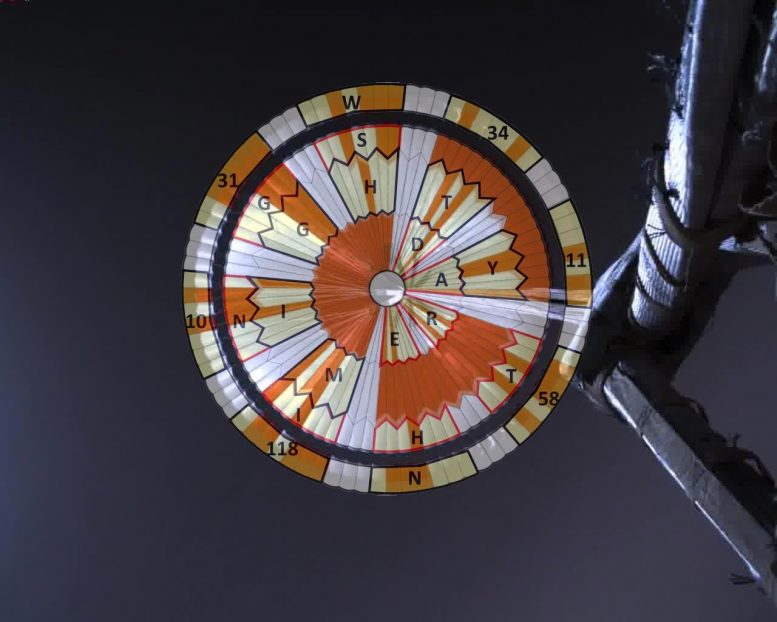
The giant canopy that helped land Perseverance on Mars was tested here on Earth at NASA’s Wallops Flight Facility in Virginia.
Test. Test again. Test again.
Testing spacecraft components prior to flight is vital for a successful mission.
Rarely do you get a do-over with a spacecraft after it launches, especially those bound for another planet. You need to do everything possible to get it right the first time.
Three successful sounding rocket missions from NASA’s Wallops Flight Facility in Virginia in 2017 and 2018 to test a supersonic parachute proved their worth with the successful landing of the Perseverance mission on the Red Planet.
After traveling 293 million miles (472 million kilometers), the supersonic parachutes, designed to slow the rover’s descent to the planet’s surface, successfully deployed and inflated. They made the smooth touchdown of Perseverance possible.

The descent stage holding NASA’s Perseverance rover can be seen falling through the Martian atmosphere in this image taken on February 18, 2021 by the HiRISE camera aboard the Mars Reconnaissance Orbiter. An ellipse indicates where Perseverance touched down. Credit: NASA/JPL-Caltech/University of Arizona
This mission required us to design and build a 72-foot parachute that could survive inflating in a Mach 2 wind in about half a second. This is an extraordinary engineering challenge, but one that was absolutely necessary for the mission,” said Ian Clark, the test’s technical lead from NASA’s Jet Propulsion Laboratory in Southern California. “To ensure they worked at Mars under those harsh conditions, we had to test our parachute designs here at Earth first. Replicating the Martian environment meant that we needed to get our payload halfway to the edge of space and go twice the speed of sound. Sounding rockets were critical to our testing and ultimately our landing on Mars.”
Watch as NASA tests a new parachute for landing the Mars 2020 rover on the Red Planet. On September 7, NASA’s ASPIRE project broke a record when its rocket-launched parachute deployed in 4-10ths of a second—the fastest inflation of this size chute in history.
The NASA team tested the parachute three times in Mars-relevant conditions, using Black Brant IX sounding rockets. The final test flight exposed the chute to a 67,000-pound (300,000-Newton) load – the highest ever survived by a supersonic parachute and about 85% higher than what the mission’s chute was expected to encounter during deployment in Mars’ atmosphere.
“When the spacecraft successfully touched down last week, it was a great feeling of accomplishment for the parachute testing team,” said Giovanni Rosanova, chief of the NASA Sounding Rockets Program Office at Wallops. “Placing the test component in the right conditions with a sounding rocket was challenging, and the importance of the tests to the success of the Mars landing was an exciting motivating factor for the team. We are proud to have been a part of this mission.”
Suborbital vehicles – sounding rockets, scientific balloons, and aircraft – are great platforms for developing and testing spacecraft instruments and components. Spacecraft including Terra, Aqua, COBE, CGRO, SPITZER, SWIFT, HST, SOHO, and STEREO have heritage connected with suborbital vehicle missions.

This annotated image was taken by a parachute-up-look camera aboard the protective back shell of NASA’s Perseverance rover during its descent toward Mars’ Jezero Crater on February 18, 2021. Using binary code, two messages were encoded in the parachute: DARE MIGHTY THINGS and the GPS coordinates of an area by JPL’s visitor center. Credit: NASA/JPL-Caltech
Rosanova said, “One of the beauties of suborbital vehicles is that an instrument or its components can be flown, improved, and then re-flown. This can be done within a few years, providing the opportunity for scientists to work out the bugs before flying on a spacecraft.”
In the case of the Mars 2020 parachutes, the first flight was a test to see if the right conditions can be achieved during the flight to simulate what the parachutes will encounter descending through the Mars’ atmosphere. The second flight, 6 months later in March 2018, was the first full test of the parachute. The final successful test, conducted in September 2018, provided the results needed for the Perseverance parachute team to be confident that the design was ready for the Mars 2020 mission.
NASA is currently developing plans for a Mars Sample Return mission to retrieve the rocks and soil samples collected by Perseverance and return them to Earth. Teams are preparing to test concepts for the Mars Ascent Vehicle that will carry the collected samples from the planet’s surface.
Suborbital vehicles – either a sounding rocket or a scientific balloon – are being examined for testing the ascent vehicle. Wallops personnel are excited to be a part of this next step of exploring the Red Planet as we go the Moon, Mars, and beyond.
More About the Mission
A key objective for Perseverance’s mission on Mars is astrobiology, including the search for signs of ancient microbial life. The rover will characterize the planet’s geology and past climate, pave the way for human exploration of the Red Planet, and be the first mission to collect and cache Martian rock and regolith (broken rock and dust).
Subsequent NASA missions, in cooperation with ESA (European Space Agency), would send spacecraft to Mars to collect these sealed samples from the surface and return them to Earth for in-depth analysis.
The Mars 2020 Perseverance mission is part of NASA’s Moon to Mars exploration approach, which includes Artemis missions to the Moon that will help prepare for human exploration of the Red Planet.
JPL, which is managed for NASA by Caltech in Pasadena, California, built and manages operations of the Perseverance rover.
https://news.google.com/__i/rss/rd/articles/CBMiaWh0dHBzOi8vc2NpdGVjaGRhaWx5LmNvbS90ZXN0aW5nLXByb3Zlcy1pdHMtd29ydGgtd2l0aC1zdWNjZXNzZnVsLW1hcnMtcGVyc2V2ZXJhbmNlLXBhcmFjaHV0ZS1kZXBsb3ltZW50L9IBAA?oc=5
2021-02-28 22:06:22Z
52781406502463
Tidak ada komentar:
Posting Komentar